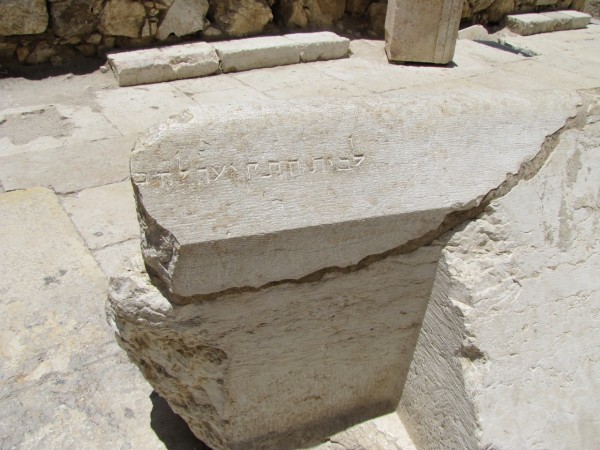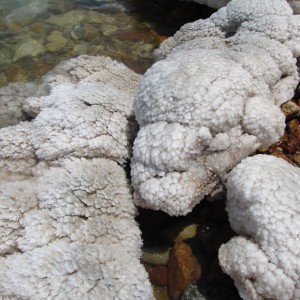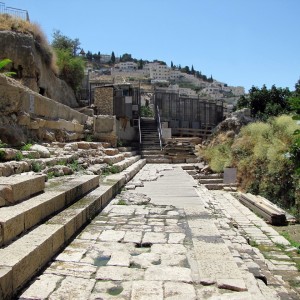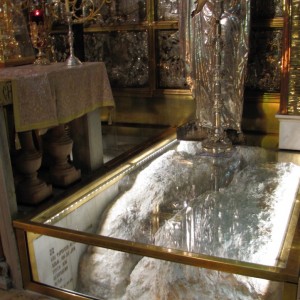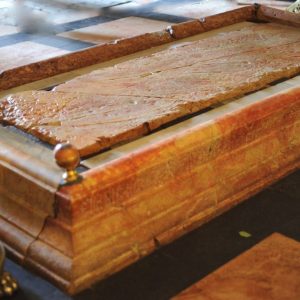The devil led Jesus to the highest point of the temple in Jerusalem. -Lk 4:9
The highest point, or pinnacle, of the Temple was the southeast corner overlooking the Kidron Valley hundreds of feet below. According to Josephus, “If anyone looked down from this summit he would be giddy, his sight being unable to encompass such an immense depth.”
In Jesus’ time the Kidron Valley would have been even deeper than today, as centuries of piled debris have raised its level. Standing with Christ at this spot, for the second time the devil mentions stones as he tries to tempt the Lord to dash out His life on the rocks below. Ultimately Jesus will surrender His life by figuratively leaping into an abyss, and a rock will seal His tomb. But that, as we know, is not the end of the story.
Equally high as the pinnacle, though with a less dramatic vertical drop, was the southwest corner near Robinson’s Arch. Known as the Place of Trumpeting, Josephus tells us the trumpeter stood here to announce the beginning and end of the Sabbath. In 1968, among the collapsed stones below Robinson’s Arch, a corner piece about eight feet long was found, bearing a fragment of Hebrew inscription which from right to left translates, “to the place of trumpeting to…” Although the writing is cut off at that point, it probably concluded with the words “herald the Sabbath.” In the Second Temple this stone was part of a parapet at the very top of the southwest corner, a place likely frequented by Jesus who, like any visitor, would have come here to admire the view over the whole of the city, both the Upper City to the west and the City of David to the south.
In ancient Israel the trumpet, or shofar, was a sacred instrument. Indeed it’s the one instrument known to be played by God Himself, or at least by His angelic cadre, for when the presence of the Lord appeared on Mount Sinai it was accompanied by “a very loud trumpet blast” that “grew louder and louder” (Ex 19:16, 19). Jesus mentions trumpets twice, once in relation to His second coming (Mt 24:31), and also in the Sermon on the Mount: “When you give to the needy, do not announce it with trumpets, as the hypocrites do in the synagogues and on the streets, to be honored by men” (Mt 6:2). No doubt this is an instance of Jesus’ fondness for hyperbole—and hilarious hyperbole at that. Imagine some rich Christian hiring trumpeters so he can stand up in church and boast of his donation to the Mission Fund!
Besides announcing the Sabbath, the trumpet was blown on other high holy days including Rosh Hashanah (New Year’s), also known as Yom Teruah or the Day of the Blast. While trumpets were originally rams’ horns, later they were also made of metal, though horn continued to be valued for its louder and more prolonged tones. Often the two were sounded in conjunction: “Make music to the Lord … with trumpets and the sound of the ram’s horn” (Ps 98:6). There was even a Feast of Trumpets, celebrated on the first day of the seventh month, which was a special sabbath, “a day of rest, a sacred assembly commemorated with trumpet blasts” (Lev 23:24).
In other cultures the trumpet has been associated with a call to arms, but among the ancient Israelites it was often the opposite: a call to peace and rest. We mark this contrast especially on the seventh day of the battle of Jericho, when seven priests blowing seven shofars led the people in seven circuits of the city, until finally one long blast on the horns signaled a great shout, whereupon the walls came tumbling down. What do all these sevens signify? Not war, but sabbath rest. This battle was to be won by resting in the Lord.
Photo by Galyn Wiemers
Next Week: The Beautiful Gate
